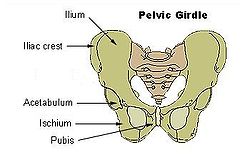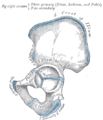- Iliac crest
-
Bone: Iliac crest Pelvic girdle. Overview of Ilium as largest bone of the pelvis. Latin crista iliaca Gray's subject #57 234 The crest of the ilium (or iliac crest) is the superior border of the wing of ilium and the superolateral margin of the greater pelvis.
Contents
Anatomy
The iliac crest stretches posteriorly from the anterior superior iliac spine (ASIS) to the posterior superior iliac spine (PSIS). Behind the ASIS, it divides into an outer and inner lip separated by the intermediate zone. The outer lip bulges laterally into the iliac tubercle. [1] Palpable in its entire length, the crest is convex superiorly but is sinuously curved, being concave inward in front, concave outward behind. [2]
It is thinner at the center than at the extremities.
Muscles
To the external lip are attached the Tensor fasciae latae, Obliquus externus abdominis, and Latissimus dorsi, and along its whole length the fascia lata; to the intermediate line the Obliquus internus abdominis. To the internal lip, the iliac fascia, the Transversus abdominis, Quadratus lumborum, Sacrospinalis, and Iliacus.
- Abdominal external oblique muscle
- Abdominal internal oblique muscle
- Transversus abdominis muscle
- Quadratus lumborum muscle
- Erector spinae
- Iliocostalis pars lumborum
- Longissimus pars thoracis[3]
- Latissimus dorsi
- Tensor fasciae latae
- Iliacus muscle
Embryology
The iliac crest is derived from endochondral bone.
Clinical significance
The iliac crest has a large amount of red bone marrow, and thus it is the site of bone marrow harvests (from both sides) to collect the stem cells used in bone marrow transplantation. The iliac crest is also considered the most ideal donor site for bone grafting when a large quantity of bone is needed. For example, oral surgeons will often use iliac crest bone to fill in large osseous defects of the oral cavity caused from severe periodontal disease, excess bone resorption following tooth loss, or trauma [4] The top of the iliac crests also marks the level of the fourth lumbar vertebral body (L4), above or below which lumbar puncture may be performed.
Additional images
See also
Notes
References
- Bogduk, Nikolai; Endres, Stephen M. (2005). Clinical anatomy of the lumbar spine and sacrum (4th ed.). Elsevier Health Sciences. p. 106. ISBN 0443101191. http://books.google.com/books?id=UYC_NpoFfAsC&pg=PA106.
- Palastanga, Nigel; Field, Derek; Soames, Roger (2006). Anatomy and Human Movement: Structure and Function. Elsevier Health Sciences. ISBN 0750688149. http://books.google.com/books?id=rRtPExr9Hz8C&pg=PA334.
- Platzer, Werner (2004). Color Atlas of Human Anatomy, Vol. 1: Locomotor System (5th ed.). Thieme. ISBN 3-13-533305-1.
This article was originally based on an entry from a public domain edition of Gray's Anatomy. As such, some of the information contained within it may be outdated.
External links
- SUNY Figs 13:02-01 - "Superficial muscles of the gluteal region and posterior thigh."
- SUNY Labs 35:os-0104 - "Anterior Abdominal Wall: Osteology and Surface Anatomy "
- Atlas of anatomy at UMich back_bone30 - "The Back, Posterior View" (#4)
- Diagram at emedx.com
- Diagram at nih.gov
Bones of pelvis / pelvic cavity (TA A02.5.01–03, GA 2.231–241) General Ilium arcuate linegluteal lines (posterior, anterior, inferior)
iliac spines (anterior superior, anterior inferior, posterior superior, posterior inferior)
other: crest · tuberosity · tubercle · fossaIschium no substructuresPubis Compound Categories:- Pelvis
- Human anatomy
- Musculoskeletal system stubs
Wikimedia Foundation. 2010.







